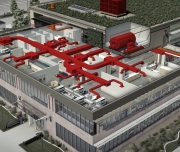System Impacts
| Human Behavior on System | System Impact on Humans |
|---|
Human Behavior on HVAC
Human behavior and interaction with the building space plays a critical component in achieving holistic sustainability. Desired gains in energy efficiency can only be achieved and sustained if the occupants and HVAC systems are working in tandem.
Occupants have one main concern when it comes to HVAC: comfort. When a space is uncomfortable, you will often see building occupants bringing in their own space heaters, humidifiers, fans and other equipment that adds to the overall building energy load. These devices are a form of system “controllability,” but not the type that is best for energy efficiency. Occupants can also impact HVAC systems by leaving equipment on unnecessarily, creating extra waste heat. Strategies to reduce the loss of conditioned air, like revolving doors, are often bypassed. Operable windows are often left open when outdoor conditions are unfavorable. To improve the effect of occupants on HVAC systems, consider the following strategies improve comfort and add convenience:
- Employ zoning strategies that give control over the thermostat to many.
- Specify raised floor systems with individual, adjustable air vents.
- Establish an easy way for occupants to request temperature or humidity changes to facility managers. In response to occupant requests, the maintenance staff may have overridden building control settings in a way that was intended to be temporary. Check these settings regularly to ensure that comfort and energy are both preserved.
- Set up electronic alerts as to when opening windows is recommended. Establish a “floor walk” routine to make sure that operable windows are closed during unfavorable conditions.
Best Practices and Strategies
| Provide individual air and temperature controls at each workstation. | Utilize CO2 sensors to assess the air quality of spaces to adjust ventilation. | Employ demand-control ventilation, tied to CO2 monitors, to deliver just the right amount of outdoor air. |
| Measure the pressure drop across filters to determine when the time is right for replacement. | Ensure that exhaust fans are installed where microwaves exist or other food preparation occurs. | Size ductwork and diffusers appropriately to reduce unwanted noise while providing some “white noise” to muffle other sounds like conversations and phone ringers. |

